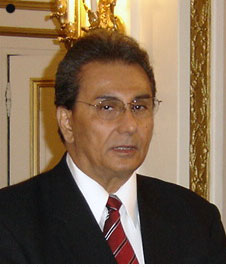 Congratulations
Pak Ismeth on your recent election as the first Governor of
the newly-created Riau Islands Province. That is a great achievement.
Can you tell our readers a little about your background and
how you came to assume this position?
Congratulations
Pak Ismeth on your recent election as the first Governor of
the newly-created Riau Islands Province. That is a great achievement.
Can you tell our readers a little about your background and
how you came to assume this position?
First of all, thank you very much. It is certainly
a privilege to be directly elected by the people of
the Riau Islands Province
(Kepulauan Riau or KEPRI) where I will serve as Governor
for the next five years (2005 – 2010), together
with Vice Governor, Mr. Mohammad Sani, the former Regent
of Karimun.
Prior to this election I served as Chairman of the Batam
Industrial Development Authority (BIDA) from 1998 – April
2005. As you know Batam is located within the Riau Islands
Province and
is the primary industrial center of Indonesia. In July
2004, I was also honored to be appointed as Acting Governor
of the
Province for about eight months, while the central government
planned for national direct elections on the provincial
level. This is part of a government effort to begin practicing
direct
elections for positions such as President, Parliament
members, Governor, Mayor, Regent, etc. in Indonesia.
Having served as both the Chairman of BIDA and Acting Governor
of the province, I was able to familiarize myself with the region,
which includes Bintan, Batam, Karimun, Lingga and Natuna Regency.
Believing I could make a major contribution to the region, I
decided to run for Governor and was elected on June 30, 2005.
During your campaign, the status of Batam (an island located
within the Riau Islands Province) as a Free Trade Zone (FTZ)
was clarified. This entailed awarding the whole island, rather
than specific parts, FTZ status. As the former Chairman of the
Batam Industrial Development Authority (BIDA) you must have been
very pleased by this announcement. Can you tell us why this was
necessary, and what it means to investors and businesses moving
forward? Can you also tell us how your own relationship with
Batam will change as you assume this new position?
 The recent ruling now means the entire island of Batam, rather
than certain parts, is recognized as a bonded area. This means
all imported goods for production purposes, such as capital goods
and raw materials, are exempted from import taxes. Batam is specifically
designed to be an export processing zone, as well as export-oriented
industrial area, so as not compete with other industrial areas,
which market their products within Indonesia. This designation
provides greater clarity and allows greater confidence from foreign
investors and business people, who are now able to conduct and/or
expand their businesses in Batam, who no longer have to monitor
transshipments on the island, lest they find themselves losing
the duty-free exemption. This is likely to further increase foreign
investment into Batam from its current level of approximately
US$ 11.53 billion.
The recent ruling now means the entire island of Batam, rather
than certain parts, is recognized as a bonded area. This means
all imported goods for production purposes, such as capital goods
and raw materials, are exempted from import taxes. Batam is specifically
designed to be an export processing zone, as well as export-oriented
industrial area, so as not compete with other industrial areas,
which market their products within Indonesia. This designation
provides greater clarity and allows greater confidence from foreign
investors and business people, who are now able to conduct and/or
expand their businesses in Batam, who no longer have to monitor
transshipments on the island, lest they find themselves losing
the duty-free exemption. This is likely to further increase foreign
investment into Batam from its current level of approximately
US$ 11.53 billion.
Since its establishment in 1978, the success of Batam
has made it into a role model – not only within the province – but
the whole of Indonesia as well as the region. Our goal is to
develop other regencies within the province so that they might
succeed in the same manner – as well as to proceed
with the continuing development of Batam itself.
Batam is one of the most established and successful FTZ’s
in Asia. At the same time, however, it remains largely
unknown outside the region. The Riau Islands attracts
even less attention.
They remain largely undeveloped, despite their natural
beauty and strategic location within the center of rapidly
developing
ASEAN markets and major shipping lanes. Do you have any
thoughts as to why this is the case, the types of opportunities
that can
be found there, and the sectors you are targeting for
future development?
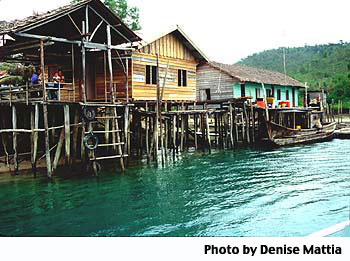
By the end
of December 2004, Batam had attracted more than 766 foreign
companies operating in Batam and accumulated a total
of approximately US$ 11.53 billion in investment. Some
well-known names include CIBA Vision, Epson, Panasonic, Phillips,
Sanyo,
Perkin Elmer, McDermott, and Advanced Interconnect
Technology.
Having achieved this success, over the past few years,
Batam has begun to reach out to new investors by participating
in various
exhibitions, seminars and road shows in Japan, Europe,
Australia and the United States. This is also helping
us to generate media
exposure that recognizes our economic potential and
achievements. With the formation of the Riau Islands
Province, we are now expanding
our focus to highlight the abundant opportunities that
exist in tourism, the oil and gas industries, fisheries,
agricultures,
transshipment and other areas. Many of these areas
have not yet been developed or recognized, by outside
investors.
Our vision is to establish the Riau Islands Province
as a center of national economic growth. Through the
development of sectors
such as those highlighted above, we plan to raise living
standards, the attractiveness of doing business here
and the quality of
our work force. While we have not yet generated recognition
commensurate with our potential or our successes, I
am confident this will
come over time. For now, however, investors benefit
as they are able to achieve the better terms and conditions
possible before
the value is more fully realized.
Batam has traditionally been an industrial center with a largely
transient population, recruited across Indonesia, who return
home after a few years of hard work. With its rapid growth, however,
Batam has grown far from its roots as a small fishing village.
As a result, in recent years many people are beginning to consider
Batam as their long-term home. This has led to the formation
of international schools, a technical college, luxury homes,
facilities for expatriates, better hospitals, shopping centers
and other trappings of modern life. Can you comment on this trend
and both the opportunities and challenges arising from this rapid
development?
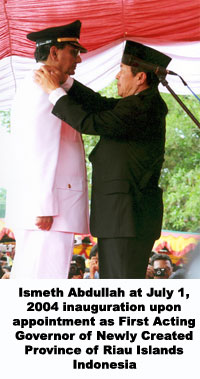 Batam
was a humble logistic center in 1978, serving a small group
of oil and gas exploration and production companies.
Today, Batam has transformed itself into one of the major industrial
hubs
and investment magnets in Asia. When one includes the
extension of Rempang and Galang Island, the area now includes
a total area
of 715 sq-km. Over the years, population growth has
been quite dramatic, from under 10,000 or so people in the
1970s to almost
600,000 people today. Batam has also become one of
the growth engines of Indonesia. It provides employment for
over 220,000
workers, and more than 900 billion Rp annually in income
taxes to the central government.
Support from the government has been
tremendous as well. It has helped to ensure the sustainable
development of the island. The autonomous status of Batam also
provides more
flexible and simpler procedures and planning. This
allows us to efficiently respond to the needs of foreign investors,
tourists
and residents.
Batam
was a humble logistic center in 1978, serving a small group
of oil and gas exploration and production companies.
Today, Batam has transformed itself into one of the major industrial
hubs
and investment magnets in Asia. When one includes the
extension of Rempang and Galang Island, the area now includes
a total area
of 715 sq-km. Over the years, population growth has
been quite dramatic, from under 10,000 or so people in the
1970s to almost
600,000 people today. Batam has also become one of
the growth engines of Indonesia. It provides employment for
over 220,000
workers, and more than 900 billion Rp annually in income
taxes to the central government.
Support from the government has been
tremendous as well. It has helped to ensure the sustainable
development of the island. The autonomous status of Batam also
provides more
flexible and simpler procedures and planning. This
allows us to efficiently respond to the needs of foreign investors,
tourists
and residents.
Development of the region is being achieved through
a Master Plan, designed to utilize the space and contour
of each island
for maximum advantage. Ideal population levels and
facilities usage in each of the eight sub-regions of
development have been
outlined. This includes the distribution of workers
and population, based on land capacity and business
activities, which determines
the optimal allocation of housing facilities. The Master
Plan is also reviewed constantly to ensure that actual
development
conforms to the plan, as well as to account for new
trends and developments, so that necessary revisions
can be made.
Despite this thorough planning, there are still challenges
that need to dealt with due to this rapid development.
This includes
migration control, to allow Batam to manage the numerous
job seekers who are arriving from all parts of Indonesia,
as well
as squatter settlements and human trafficking. Hence,
Batam continues to strive and change, in order to resolve
our problems and to
create the most conducive and productive climate possible.
The Riau Islands province was only formed a little over a year
ago. Can you tell us why a decision was made to incorporate these
islands into an independent province? In addition, given many
of the islands are small and transportation between them difficult,
can you talk about the opportunities that can be found there,
as well as the challenges of initiating a balanced development
plan, particularly when the provincial economy is dominated by
industrial activity on Batam, tourism in Bintan and oil and gas
exploration in Natuna?
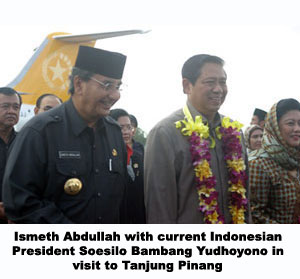 The
Riau Islands Province was established on July 1, 2004 by the
government of Indonesia from land formerly incorporated within
the province of Riau. Due to its strategic location,
close proximity
with Singapore and International borders and the unique
needs of the hundreds of islands that comprise the archipelago,
the
Central Government decided it would be better served
if incorporated into a new province. This allows better supervision
and more
attention to the development needs of this area.
The
Riau Islands Province was established on July 1, 2004 by the
government of Indonesia from land formerly incorporated within
the province of Riau. Due to its strategic location,
close proximity
with Singapore and International borders and the unique
needs of the hundreds of islands that comprise the archipelago,
the
Central Government decided it would be better served
if incorporated into a new province. This allows better supervision
and more
attention to the development needs of this area.
Each of the regencies incorporated in the Riau Islands
Province has its own opportunities that can be offered
to potential investors.
For example, the Regency of Kepulauan Riau offers prospects
in industry, mining, agribusiness, housing, fisheries,
water resources
and tourism. The Regency of Karimun offers opportunities
in shipyards, industry, agribusiness, fisheries, mining,
and tourism. The Regency
of Natuna focuses on fisheries, farming and plantations,
animal husbandry, mining and tourism. The Regency of
Lingga allows opportunities
in agro-industry, animal husbandry, tourism and industry.
The City of Tanjung Pinang possesses potential in industry,
shipbuilding,
fisheries and tourism, and finally the City of Batam,
trade and industry, industrial parks, agribusiness
and tourism.
Part of the attraction of Batam and the Riau Islands is their
proximity to Singapore. Speaking from a New York City perspective,
this would be similar to having a large Free Trade Zone with
only a fraction of the labor and infrastructure costs of Manhattan
on Staten Island with several thousand nearby islands offering
tremendous potential for tourism and other industries. Can you
tall us about the relationship between Singapore, Batam and the
Riau Islands and what it means for foreign investors and businesses?

Batam is
indeed a unique place in Indonesia as it has Singapore for
a neighbor. Located only 12 miles away, Batam and
the Riau Islands and Singapore consider each other partners
for growth.
This world-class business and financial center provides
cutting-edge infrastructure and attractive incentives, combined
with the cost
savings and enhanced competitiveness that can be
achieved through basing facilities within the lower cost structure
of
Indonesia.
In addition, many products manufactured or assembled
on Batam qualify as Singaporean under the Singapore-U.S.
Free Trade Agreement
. This relationship benefits both industrial activities
as well as tourism, and Singapore’s advanced facilities have turned
the island into a modern city. Many executives now commute between
the two on a regular basis. Singaporeans come to work on Batam
during the week or visit on weekends to enjoy golfing, good food,
our beaches and other activities. At the same time, residents
of Batam are able to access services in Singapore or come to
enjoy shopping and cultural events. Singapore is also the largest
investor in Batam, and around 500, or 2/3, of the foreign companies
operating on the island are Singaporean. This allows the option
of utilizing legal and accounting firms, schools, hospitals and
other facilities – or the alternatives we have
been developing on Batam. This has deepened business
as well as social relations.
As a result more cooperation and mutual agreements have
also been reached in areas such as trade and education.
Through their
expansion into Batam, companies are able to maximize
their competitiveness. They are able to reduce investment
costs as well as that of their
operations. Singapore also serves as a benchmark. It
stimulates the province to continue to improve our capabilities
and capacity
to provide first class services to investors, tourists
and trading partners.
Most American executives are unfamiliar with how to do business
in Asia and fewer still would be able to recognize what ASEAN
stands for and where it is located. Given this lack of awareness,
can you talk about the potential of ASEAN and why, given all
of the attention presently being accorded to opportunities in
China, India and other markets, it is worthy of the attention
of international business executives and investors?
Indonesia is a member of ASEAN (Association of the Southeast
Asian Nations) . Collectively this is a market of
approximately 500 million people with a combined gross domestic
product
of US$600 billion. It includes other countries such as Brunei
Darussalam,
Cambodia, Laos, Malaysia, Myanmar, Philippines, Singapore,
Thailand, and Vietnam. Although the world is currently focusing
more attention
of China and India, the ASEAN region also holds a
lot of potential and is well worth the attention of international
executives and
investors.
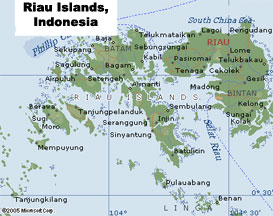 ASEAN,
for example, is a leading recipient of Foreign Direct
Investment (FDI) inflows in the developing world,
with five ASEAN countries in the top 20 developing-countries
recipients of long-term
global capital flows during the late 1990s. Economies
in the region continue to undertake collective, as
well as individual,
measures to further liberalize their investment regimes
and to provide competitive and attractive investment
environments. Additional
policy measures have been introduced to attract greater
FDI flows and to develop the region’s competitiveness
as a business and investment destination.
ASEAN,
for example, is a leading recipient of Foreign Direct
Investment (FDI) inflows in the developing world,
with five ASEAN countries in the top 20 developing-countries
recipients of long-term
global capital flows during the late 1990s. Economies
in the region continue to undertake collective, as
well as individual,
measures to further liberalize their investment regimes
and to provide competitive and attractive investment
environments. Additional
policy measures have been introduced to attract greater
FDI flows and to develop the region’s competitiveness
as a business and investment destination.
On an individual basis, Indonesia offers qualified
investors 100% foreign-equity ownership in wholesale
and retail trading
companies, as well as all areas of the manufacturing
sector. Indonesia has also reduced the processing
time required for the
approval of investments of less than US$100 million
to 10 working days. In addition, listed Indonesian
banks are now open to 100%
foreign-equity ownership. Brunei Darussalam allows
100% foreign-equity ownership in high technology
manufacturing and export industries.
Laos allows duty exemptions on imported capital goods
required by promoted investment projects. Malaysia
offers 100% foreign-equity
ownership in the manufacturing sector, with no export
conditions imposed on new investments, expansions
and diversifications.
Myanmar has extended a minimum three-year corporate
tax exemption to investment projects in all sectors.
The Philippines has opened
its retail and distribution sectors to foreign equity,
and allows foreign companies to compete in the domestic
private construction
sector. And Singapore has reduced business costs
significantly as part of a package amounting to savings
of US$10
billion, in addition to extending a 30% investment
tax allowance to industrial
projects and to selective service industries. One
hundred percent foreign-equity ownership for manufacturing
projects regardless
of location is also now allowed by Thailand. Finally,
Vietnam allows duty exemptions for imported capital
goods for all projects.
In addition to these actions, member economies are
collectively promoting ASEAN as a single investment
area. This includes a
general reduction of trade and other barriers with
an overall vision of realizing an ASEAN Investment
Area by 2010 and the
free flow of investments by 2020 . Regional cooperation
will facilitate more cost-effective industrial and
production activities,
providing firms with greater synergy and competitive
edge in servicing both global markets. It will also
provide better access
to this major emerging consumer market as well.
Let me also mention Batam had the pleasure of hosting
the First ASEAN People’s Assembly in November 2000. This event was
attended by 300 members from ten countries. As the First ASEAN
People’s Assembly, Batam was pleased to launch
this annual event, which continues to bring together
our people, countries
and region.
Despite its immense natural wealth, large population,
high growth potential, and emergence as the world’s largest Islamic
-- though secular-oriented -- democracy, Indonesia in many ways
remains a “stealth economy” and rarely receives
mention within international media. Can you tell us about
the potential
of Indonesia, current trends, and why investors and internationally-focused
firms as well as policymakers would be wise to pay it more attention?
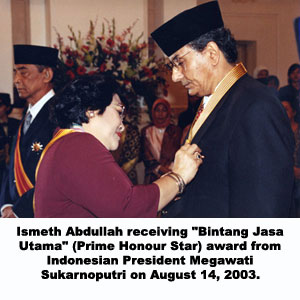 As
a member nation of ASEAN, Indonesia is located on the crossroads
of two great continents, Asia and Australia, and
the Indian and Pacific Oceans, by which goods move through
from
Asia to the
Middle East, Europe and Africa. Indonesia possesses
comparative advantages to investors offering a vast, fertile
country endowed
with rich and diversified natural resources. This
includes a wide range of agricultural products, plantations,
fisheries,
mining, oil and gas. It also possesses a large population
of
about 210 million with increasing industrial and
consumer needs. This constitutes a huge potential market with
an increasingly
competitive work force and business environment.
It also offers
a strategic location control of vital international
sea communication lines; a stable democratic government;
open market-oriented economy,
with free foreign currency exchange regime.
As
a member nation of ASEAN, Indonesia is located on the crossroads
of two great continents, Asia and Australia, and
the Indian and Pacific Oceans, by which goods move through
from
Asia to the
Middle East, Europe and Africa. Indonesia possesses
comparative advantages to investors offering a vast, fertile
country endowed
with rich and diversified natural resources. This
includes a wide range of agricultural products, plantations,
fisheries,
mining, oil and gas. It also possesses a large population
of
about 210 million with increasing industrial and
consumer needs. This constitutes a huge potential market with
an increasingly
competitive work force and business environment.
It also offers
a strategic location control of vital international
sea communication lines; a stable democratic government;
open market-oriented economy,
with free foreign currency exchange regime.
Investment policy in Indonesia is very open to foreign
investment. This is indicated by the fact only a
small number of sectors
are restricted. Many fiscal incentives have also
been implemented to attract foreign investors and
there
is no limitation on the
value of investments that can be made. Foreign investors
are also now able to wholly own investments in almost
every sector
and to take advantage of simplified approval processes.
The Indonesian Government realizes that investment
is one of the most important
factors in driving economic growth and, thus, is
trying hard to improve investment procedures to stimulate
a more favorable
investment climate.
When Indonesia is mentioned in international media, it is usually
within the context of the potential for terrorism, corruption,
natural disasters, piracy, disputes with foreign companies and
other negative factors. Do you think this is fair and what would
you tell executives and investors that are inclined to pass over
Indonesia due to these concerns?
It is true media coverage of Indonesia has focused on negative
issues such as the potential for terrorism, corruption,
natural disasters, piracy and other issues. This has made
some investors
hesitant, however, that is not unusual as the media
often tends to emphasize negative news over positive achievements.
In fact,
Indonesia has made rapid advances in recent years,
initiating
substantial restructuring and reform and many exciting
political, economic and social changes. Under the new government
of President
Soesilo Bambang Yudhoyono (SBY) policies are being
established to enhance further progress. This includes efforts
to
fight terrorism and corruption, improve the people’s welfare,
and to provide better public services to Indonesian citizens
as well as foreign
investors. In addition the nation has truly embraced
democracy on the national as well as local level, and our political
situation
is increasingly stable and security concerns are being
addressed.
Despite all the negative coverage, many foreign investors
are conducting businesses in Indonesia. They are
coming to recognize
the significant potential offered within a rapidly
developing economy of 210+ million people -- which has gone
largely
unexplored in comparison with our neighbors. Indonesia
is a fertile country,
endowed with substantial natural resources. This
is increasingly important as worldwide demand and consumption
rises with
larger numbers of people within China, India and
other
markets entering
the workforce. Indonesia is a huge potential market
and offers a competitive work force. It offers a strategic
location controlling
vital international sea communication lanes. Indonesia
is also a democratic country; an open market-oriented
economy, with free
foreign currency exchange regime. Given that it is
also attracting less attention when compared to China and
India, there is also
less competition. Many also find living conditions
and the working environment easier and more pleasant to deal
with. Ultimately “seeing
is believing” and I urge observers not to believe
the tales they have heard. Come and make a personal judgment
for yourself.
I am confident once they do, you will become attached
and recognize the potential of doing business in our
country.
The move toward decentralization and localization is quite new
in Indonesia as well as many other Asian countries. Can you tell
us about the changing relationship between national and local
government in Indonesia, the challenges you are facing, and what
this means within the Riau Islands in particular?
Although decentralization and localization are quite new in
Indonesia, the practice is being adopted rapidly to ensure
that government
policies are effectively executed. This transition
is now taking place and we are working out the lines of decision
making, to
determine which policies and responsibilities are
best handled by local government and which at the national
level.
With the newly-created Riau Islands Province we are
now urgently moving to implement a far-reaching agenda
that will help to create
a clean, authorized, and beneficial government. Some
of these include steps to raise the income of government
officials, restructure
bureaucratic practices and to generally improve the
quality and standards of public service.
Bureaucratic restructuring is essential to the practice
of good, clean government, hence we are emphasizing
and creating a greater
awareness of the basic principles of accountability,
transparency, personal and social responsibility,
as well as law enforcement.
However, to do that, the quality human resources
of government officials, as well as the principles
of
citizen participation,
will need to be further improved, through training
and leading by example.
Given the wide range of constituencies within our
borders, ranging from small traditional fishing villages,
to
modern industrial
parks, tourism facilities, agricultural plantations,
fishing and shipping operations and other industries
this will not be
easy. It is, however, a challenge that I embrace
and will dedicate myself to resolving, over the coming
years.
One development worth noting is the attention you have been devoting
to help Batam establish a wide network of international relationships.
For example, last year you traveled to New York and Washington
and in July negotiated a memorandum of understanding to allow
greater cooperation between Batam and the Aqaba Special Economic
Zone in Jordan. Plans are also underway to visit Korea, Finland
and other markets. Can you tell us more about these activities,
how they will help Batam, and now that you are assuming the Governorship,
how you might expand these initiatives to help the province as
a whole?
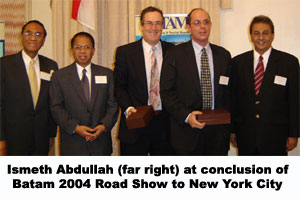 Establishing
good networks and relationships around the world constitutes
one of the key elements of achieving success in a
global economy. Batam, currently has received investments
from over 34 different countries, and we have been moving
to reach
out to potential partners all over the world to enhance
our competitiveness as a manufacturing and service platform.
Under my governorship
of Riau Islands Province, I plan to continue such
practices though now on a provincial level, as I believe that
our region
offers
abundant opportunities and we can now offer even
stronger reasons to locate within our borders. With the support
and
helping hand
of our overseas partners as well as foreign investors
who have already established operations here, I have great
confidence
we can achieve great things and make the Riau Islands
Province into an example for both Indonesia and the region
as a whole.
Establishing
good networks and relationships around the world constitutes
one of the key elements of achieving success in a
global economy. Batam, currently has received investments
from over 34 different countries, and we have been moving
to reach
out to potential partners all over the world to enhance
our competitiveness as a manufacturing and service platform.
Under my governorship
of Riau Islands Province, I plan to continue such
practices though now on a provincial level, as I believe that
our region
offers
abundant opportunities and we can now offer even
stronger reasons to locate within our borders. With the support
and
helping hand
of our overseas partners as well as foreign investors
who have already established operations here, I have great
confidence
we can achieve great things and make the Riau Islands
Province into an example for both Indonesia and the region
as a whole.
Thank you very much Pak Ismeth for your time and attention. Before
we conclude, do you have any final comments you would like to
leave to our readers?
I would like again to thank the people of the Riau Islands
Province, who have elected and entrusted me to become the
first Governor of Indonesia’s newly-created 32nd province. I hope all
the people living together in Riau Islands Province will join
hands and work together for the progress of the region. I also
hope international investors and business executives – many
of whom have already become familiar with Batam – will
recognize the increased possibilities available throughout
the province. Finally, I invite all of your readers to
visit the
Riau Islands Province, so that they can see for themselves
the opportunities that lie within our borders, as well
as to enjoy
Indonesian hospitality and a region, full of exciting
tourism activities. Thank you.
To access recent news coverage and additional information
on Batam and the Riau Island Province, please click
on the links
below:



